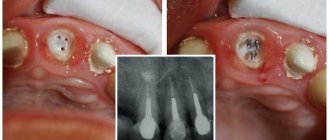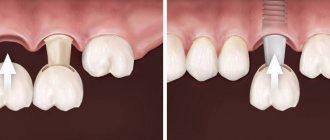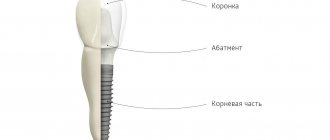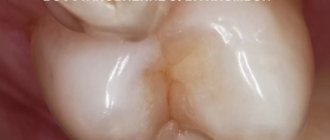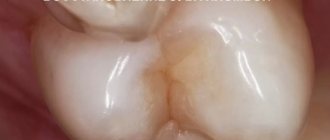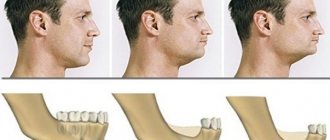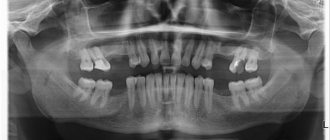If a tooth is severely damaged, there is a choice - to restore the problematic unit with a crown or remove it and install an implant. Both options are used to replenish the dentition. The crown restores only the upper part; the root must be healthy to avoid complications in the future. This type of prosthetics has optimal prices and few contraindications, but there is no guarantee that it will last long in case of poor-quality root canal treatment. An implant is a full-fledged copy of a lost tooth; a titanium root is implanted into the jaw, performs the functions of a real one, and is covered with a crown on top. Implantation is an expensive treatment option, but it comes with a lifetime guarantee.
What is the difference between a dental implant and a crown?
- An implant is an artificial metal root that is surgically installed into the jawbone. Made of non-toxic medical titanium, hypoallergenic, not rejected by the body. The crown is fixed on top - immediately after installing the implant or after it has fused with the bone tissue. The duration of prosthetics depends on the chosen implantation protocol - based on the results of an analysis of the condition of the bone tissue. The service life of the implants is lifelong; you only have to change the crown once every 15 years, and if properly cared for, the service life is the same.
- Crown - a prosthesis made of ceramic, zirconium or other material. This is the top of the dental unit, a kind of cap that is attached to the preserved part. Restores the aesthetic defect and functions of the coronal part. An important condition for this method of restoration is the absence of inflammation at the root. Constructions that rely on your own teeth last up to 10 years, and in case of inflammatory processes they have to be removed to re-treat the roots.
The fundamental difference between an implant and a crown is the installation method. To place an implant, it is necessary to remove the problematic unit of the dentition. The crown is installed on your own tooth, as it needs support, and only partially restores it; it is the upper outer shell. In addition, methods differ in service life, price and other parameters.
What is a crown
A tooth crown is an orthopedic structure that is used to eliminate defects in a damaged tooth or restore a completely lost dental unit. A missing or severely damaged tooth can be restored with a crown. Advantages of restoration with crowns:
- a crown can restore a badly damaged tooth when therapeutic treatment is no longer effective;
- replacement possible in case of breakdown;
- large selection of orthopedic materials;
- correct distribution of chewing load.
Even if more than 50% of a tooth is destroyed, it can be restored with a crown. Chips, cracks and carious processes can also be indications for prosthetics using crowns. At the moment, there is a wide selection of materials for the manufacture of orthopedic structures. In addition, crowns can vary in cost, aesthetics and service life:
- Plastic. Most often used as temporary crowns.
- Metal-ceramic. These crowns are covered with ceramic on top and made of metal on the inside. They are one of the most popular types of orthopedic structures, due to their aesthetic characteristics and the relatively low cost of the product.
- Crowns made of precious metals. As a rule, they are installed for people who are allergic to metal.
- Ceramic, zirconium dioxide-based crowns. More expensive designs that accurately replicate the anatomical features of the damaged tooth. They are matched to the natural color of the enamel, strong and durable.
Before installing a crown, the tooth is ground down, impressions are taken from it, and the future crown is made from it.
Pros and cons of methods
Implantation
Advantages
- Lifetime service life and warranty in our Center
- No bone atrophy around the implant
- High chewing loads, no restrictions on food consumption
- High aesthetics
- Easy care
Flaws
- Requires surgical intervention, causes concern for patients
- Possible contraindications to surgery
- Rehabilitation from 2 to 6 months
- The cost is higher than restoration with crowns
- Possible rejection if recommendations are not followed
Installation of crowns
Advantages
- Non-traumatic installation
- Installed in 1-3 doses, if no prior treatment is required
- Virtually no contraindications
- Satisfactory aesthetics
- The cost is lower than when installing implants
Flaws
- Short service life - on average 7 years
- Do not load with too hard food
- If the condition of the root is unsatisfactory, its treatment is required - up to 1 month
- The likelihood of developing inflammatory processes under the crown
- If there is little tissue left, it is necessary to make a stump inlay, which increases the cost
Implant attachment
The implant and crown are secured using a material such as cement. It provides strong and 100% grip. In dental practice, there are situations when temporary crowns are initially installed on an implant. After some time, they are removed and permanent ones are attached.
The crown on the implant tends to wear out and become loose over time. In this case, it is not worth restoring it; it is better to resort to complete replacement.
The implant is installed with the mandatory use of anesthesia. It is done locally. Next, the prosthesis is slowly implanted into the gum and internal suturing is performed. After a long time (about 3-6 months), the implant grows into the jaw. Then the gum former is installed. Afterwards, an impression of the gum is made, on the basis of which a crown is made. It should be noted that dentures take root faster on the lower jaw than on the upper jaw.
What to put on a dead tooth
A dead tooth is pulpless, without a nerve. A root without pulp becomes brittle and may not withstand heavy loads. If the root breaks, the prosthesis will need to be changed urgently. It will not be possible to preserve the old design; you will have to make a new one, and this will be an unforeseen expense. In the case of implantation, there are no such risks.
In addition, in case of severe damage, the dental unit must be strengthened and a pin installed in the root. But even with a positive prognosis, there is no guarantee that a crown with a pin will last at least 10 years. In case of critical damage, stump inlays are installed, which are made according to casts to order. The recovery process becomes longer and more expensive.
In difficult cases, there is no guarantee that the structure will last long. Therefore, it is necessary to assess the condition of the tooth and predict the duration of its functioning. If the prognosis is unfavorable, it is better not to spend money, remove the problematic molar or incisor, and install an implant that will last a lifetime.
If the cost of restoration with a crown with preliminary treatment is comparable to implantation, preference is given to the latter. You will receive a warranty from the manufacturer and from the clinic for the implant, and a 1-year warranty for treatment and prosthetics.
What is better to put on chewing and front teeth?
If the incisors or molars are well treated, only the crown part is destroyed, and the root is not affected by caries, there are no cracks or inflammations, crowns can be placed. But you need to choose the right materials.
Restoration of the anterior incisors must meet high aesthetic requirements. The best option is a single prosthesis made of metal-free ceramics (it has natural translucency, is as similar as possible to natural enamel, but does not withstand heavy chewing loads).
Chewing molars are subject to severe stress, so it is important that the restoration method is reliable. You should choose durable materials, the best is zirconium dioxide - it is not inferior in strength to metal ceramics, but is more aesthetically pleasing and durable.
If the dentist has doubts about the quality of treatment, it is better to perform an extraction and install implants. There are methods of immediate implantation immediately after removal into a fresh socket - this will shorten the treatment time, there is no need to wait for healing or restoration of bone tissue.
For anterior incisors, a prosthetic restoration can be placed immediately using an immediate loading protocol. It is better not to load chewing teeth immediately, but to carry out classical implantation with delayed loading, because implants can become dislodged when chewed.
Sometimes the difference between implantation and crown installation is only a couple of thousand rubles
Sometimes the difference is only a couple of thousand rubles due to the need for preliminary treatment before installing an orthopedic structure. If the tooth is severely damaged, additional costs will be required - strengthening with a pin or inlay. The patient pays for depulpation and root canal treatment. In addition, caries often develops under the denture. Even with good treatment, the root with the removed nerve is vulnerable to infection and is fragile, it can break even under light load.
Levin Dmitry Valerievich
Chief physician, Ph.D.
Implants come with a lifetime warranty. The most that will need to be replaced is a prosthesis. As research has proven, the service life of orthopedic structures based on artificial rather than living roots increases by 30–40%. With daily careful hygiene, the service life coincides with the implants.
Implants and crowns: what are the disadvantages?
The disadvantages of single dentures include:
- Significant risk of damage to adjacent healthy teeth.
- Fragility of non-metallic structural elements.
- Possibility of complications:
- if the size is incorrectly selected, they rub and provoke the development of inflammation;
- a small gap remains between the gum and the crown, in which food debris can accumulate, causing an unpleasant odor and destruction of the jaw structures;
- allergic reactions to the material from which a single prosthesis is made are possible;
- development of galvanic syndrome - if there are orthopedic structures made of different metals in the mouth, the patient may experience a metallic taste and headaches;
- risk of gum receding, exposure of the dental neck.
- Short service life compared to implants. The crown is fixed on a pulpless tooth, the destruction of which is a matter of time.
- Consumption of solid foods is contraindicated.
Implants also have disadvantages:
- There is a risk of rejection.
- The procedure for implanting a titanium root is more painful than prosthetics (the disadvantage is eliminated by the use of anesthetic drugs).
- Duration of the method. It takes 4-6 months for the rod to fully engraft.
- Risk of complications:
- damage to the mandibular nerve;
- perforation of the maxillary sinus with small bone volume;
- seam divergence;
- development of inflammation and infection.
- The need for long visits to the dental clinic.
- When installing several implants, to properly distribute the load, a separate orthopedic structure is placed on each one.
- Complete restoration of the dentition in just 4 days!
more detailsRoott Pterygoid Implants Sinus lift is no longer needed!
more details
Once and for life! Express implantation in 4 days with a permanent ReSmile prosthesis
more details
All-on-4, All-on-6, ReSmile, Zygomatic implantation We use all modern methods of dentition restoration
more details
What to choose - to summarize
| Implant | Crown | |
| Traumatic installation | high | short |
| Speed of tooth restoration | 2-6 months | from 2 days |
| Reliability of fixation | very high | above average |
| Need for replacement | No | Yes |
| Possibilities | any missing tooth | if there is no fracture and inflammation at the root |
| Life time | for life | 5-15 years |
| Price | high | depends on the need for pre-treatment |
Implants are reliable and durable. They imitate the structure of an incisor or molar. The lifetime service life of the titanium rod can be guaranteed. But surgical intervention is a necessary measure; no implant can replace a natural root. The dentist’s task is to preserve even part of the element of the dental system. A well-treated tooth and a correctly installed orthopedic structure create conditions for long service life and high aesthetics.
On the other hand, a root without pulp can no longer be called complete. Without nutrition, tissue breaks down, leading to organ loss. Then, in order to pay twice, it is better to install the implant immediately.
The doctor will tell you what is best to choose after diagnosis and examination.

